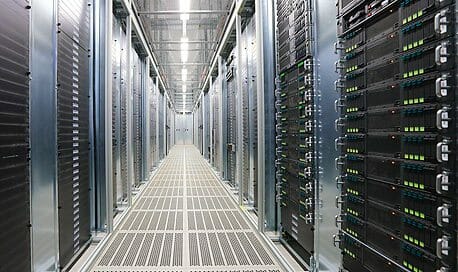Airflow Management vs. Thermal Management: What’s the Difference?10 min read

It comes as no surprise that in any conversation around data center energy efficiency, cost reduction, and overall health of IT infrastructure, there lies two common denominators: airflow management and thermal management. While they are commonly coupled together as ‘one in the same’, there are distinct differences between the two. A common misconception is that improving airflow management will improve thermal management. This, however, is not the case.
Now, before we jump into this discussion, it is important to note what each of these terms refers to:
- Airflow management (AFM) refers to the directing and blocking of conditioned and exhaust air through the use of many devices such raised perforated tiles and grills, grommets, blanking panels, and containment just to name a few. The second part of airflow management, which is often left out, is managing the volumetric flow rate. The volumetric flow rate is managed by changing fan speeds, or completely turning cooling units on or off if they have no variable speed drives (VSDs).
- Thermal management is broadly defined as the ability to control the temperature of a system by means of technology based on thermodynamics and heat transfer. The phrase thermal management is, therefore, describing all possible means and processes like heat transfer, conduction, convection, condensation, and radiation, etc. to increase or decrease the temperature and/or the temperature distribution of a specified system. In the computer room, thermal management relates to the process of removing heat from chips and other electronic components and removing heat from the air through the use of cooling units.
Why They Are Different
The goal of all airflow management initiatives is to improve or maintain the intake air temperatures to IT equipment so that the flow rate of conditioned air can be reduced as much as possible. More specifically, to reduce the highest intake air temperatures so that all intake temperatures are as low and even as possible. This, in return, enables changing the control of cooling infrastructure, or the thermal management, to improve efficiency and increase capacity.
Thermal management refers to changing the control of cooling infrastructure, specifically the temperature set points of the cooling units, and therefore the operating temperatures of the system. A common misconception is that changing airflow management will change thermal management or the operating temperatures of the system. Proper airflow management only enables the changing of temperature set points but will have no effect on overall operating temperatures if action isn’t taken. While improvements to airflow management can change the intake temperature of IT equipment, it will not change the return air temperature to the cooling units, because it is electronically controlled by the cooling unit.
It’s All Part of the Process
To avoid confusion, an easy way to look at this is a process, where energy efficiency, cost reduction, and overall health of your IT infrastructure is the goal. While both airflow management and thermal management are part of this process, they should be considered as different steps in the process. The process is as follows:
1. Manage Airflow: Ensure cold air is where it needs to be and prevent the mixing of hot exhaust air through perforated tile placement, installation of raised floor grommets, use of blanking panels, sealing gaps between racks, and implementing containment.
2. Adjust Airflow Rate: If your cooling units have VSD reduce fan speed as much as possible without IT equipment intake air temperatures exceeding your desired maximum. If your cooling units do not have VSD then turn off as many units as possible, again without causing IT equipment intake air temperatures to exceeding your desired maximum. Calculating your Cooling Capacity Factor (CCF) will help you identify your opportunity for reducing fan speed and turning off cooling units.
3. Raise Cooling Unit Set Points: While the standard for return air temperature setpoint has been increasing over the years, it is really the intake air temperature to the IT equipment that drives all settings. With either return or supply temperature control, the set point should be as high as possible without IT equipment intake air temperatures exceeding your desired maximum. The better the airflow management in the computer room the higher the control set point can be.
4. Adjust Other Cooling Infrastructure Controls: Once airflow management and controls have been adjusted in the computer room it will likely be possible to modify other controls. With the computer room running more efficiently air and water side economization hours can likely increase. Also, chilled water set points can likely be raised increasing the chiller efficiency. And depending on your system condenser water and fan controls may also be modified to improve efficiency.
Conclusion
While airflow management and thermal management should both be addressed when considering efficiency, cost reduction, and the health of your IT infrastructure, there are distinct differences between the two. The major takeaway is, implementing airflow management improvements come first, then thermal management changes can be made in the computer room and throughout the entire supporting cooling infrastructure. Airflow management improvements alone will have little to no effect on improving efficiency and reducing operating cost. Thermal management is necessary to increase the capacity and efficiency of the cooling units and maximize the benefits of airflow management.
Although airflow management and thermal management are certainly interdependent, recognizing the difference between them will help you maximize both the effectiveness and efficiency gains that can be realized by improving either one.

5 Comments
Submit a Comment
Airflow Management Awareness Month
Free Informative webinars every Tuesday in June.







Very Good informative essay related to data center cooling
Hello Ali, glad you found it valuable. If you have any related questions let me know. Thanks, Lars
Hi Lars, interesting article. Be glad to have deeper discussion about effects of fluid dynamics on both areas. We have have testimonial after testimonial in live data center testing and now have scientific validation of Triad benefits that have effect of rising cooling set point, improving heat transfer at front/ back of servers and returning hotter air more rapidly to CRAC.
Kind Regards,
Gary
Hello Gary, I would like to continue this conversation. Lets connect my email.
Thanks, Lars
“While improvements to airflow management can change the intake temperature of IT equipment, it will not change the return air temperature to the cooling units, because it is electronically controlled by the cooling unit.”
It may change the input temp (to A/C) by preventing mixing of airstreams. It will not affect output temp(from A/C) which is controlled by the A/C unit
“While improvements to airflow management can change the intake temperature of IT equipment, it will not change the return air temperature to the cooling units, because it is electronically controlled by the cooling unit.”
It does change the input temp to the A/C unit. It does not change the output temp which is controlled by the A/C unit.